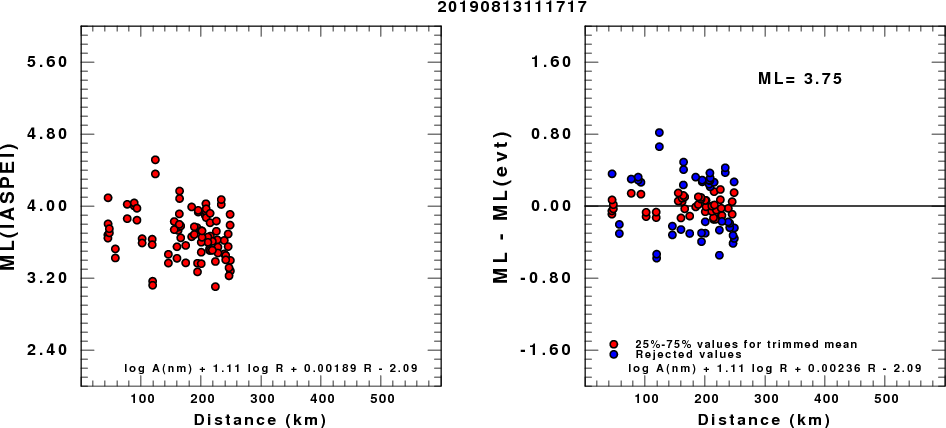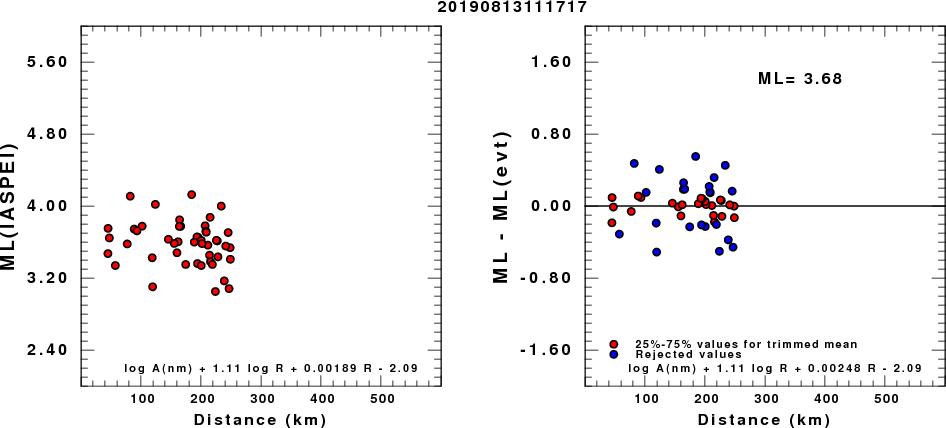Location
2019/08/13 11:17:17 44.47 9.82 7 3.9 Borgo Val di Taro (PR)
Arrival Times (from USGS)
Arrival time list
Felt Map
USGS Felt map for this earthquake
USGS Felt reports page for
Focal Mechanism
SLU Moment Tensor Solution
ENS 2019/08/13 11:17:17:0 44.47 9.82 7.0 3.9 Borgo Val di Taro (PR)
Stations used:
FR.EILF FR.ESCA FR.MON FR.SAOF FR.SPIF FR.TURF GU.ENR
GU.GBOS GU.GORR GU.PCP GU.POPM GU.PZZ GU.RORO GU.ROTM
GU.RRL GU.STV IV.ASQU IV.ATMI IV.BDI IV.BOB IV.CELB IV.CRE
IV.CRMI IV.CSNT IV.IMI IV.MONC IV.OSSC IV.PARC IV.PIEI
IV.PLMA IV.QLNO IV.SACS MN.VLC
Filtering commands used:
cut o DIST/3.3 -20 o DIST/3.3 +40
rtr
taper w 0.1
hp c 0.03 n 3
lp c 0.10 n 3
Best Fitting Double Couple
Mo = 5.31e+21 dyne-cm
Mw = 3.75
Z = 9 km
Plane Strike Dip Rake
NP1 120 65 -75
NP2 268 29 -119
Principal Axes:
Axis Value Plunge Azimuth
T 5.31e+21 19 199
N 0.00e+00 14 294
P -5.31e+21 67 57
Moment Tensor: (dyne-cm)
Component Value
Mxx 4.02e+21
Mxy 1.08e+21
Mxz -2.56e+21
Myy -9.64e+19
Myz -2.15e+21
Mzz -3.93e+21
##############
######################
############################
########--------------########
######-----------------------#####
####----------------------------####
--#--------------------------------###
---#----------------------------------##
-####------------------ -------------#
-#######---------------- P --------------#
-########--------------- ---------------
###########-------------------------------
##############----------------------------
###############-------------------------
###################---------------------
######################----------------
###########################---------
##################################
######## ###################
####### T ##################
#### ###############
##############
Global CMT Convention Moment Tensor:
R T P
-3.93e+21 -2.56e+21 2.15e+21
-2.56e+21 4.02e+21 -1.08e+21
2.15e+21 -1.08e+21 -9.64e+19
Details of the solution is found at
http://www.eas.slu.edu/eqc/eqc_mt/MECH.IT/20190813111717/index.html
|
Preferred Solution
The preferred solution from an analysis of the surface-wave spectral amplitude radiation pattern, waveform inversion and first motion observations is
STK = 120
DIP = 65
RAKE = -75
MW = 3.75
HS = 9.0
The NDK file is 20190813111717.ndk
The waveform inversion is preferred.
Moment Tensor Comparison
The following compares this source inversion to others
| SLU |
SLU Moment Tensor Solution
ENS 2019/08/13 11:17:17:0 44.47 9.82 7.0 3.9 Borgo Val di Taro (PR)
Stations used:
FR.EILF FR.ESCA FR.MON FR.SAOF FR.SPIF FR.TURF GU.ENR
GU.GBOS GU.GORR GU.PCP GU.POPM GU.PZZ GU.RORO GU.ROTM
GU.RRL GU.STV IV.ASQU IV.ATMI IV.BDI IV.BOB IV.CELB IV.CRE
IV.CRMI IV.CSNT IV.IMI IV.MONC IV.OSSC IV.PARC IV.PIEI
IV.PLMA IV.QLNO IV.SACS MN.VLC
Filtering commands used:
cut o DIST/3.3 -20 o DIST/3.3 +40
rtr
taper w 0.1
hp c 0.03 n 3
lp c 0.10 n 3
Best Fitting Double Couple
Mo = 5.31e+21 dyne-cm
Mw = 3.75
Z = 9 km
Plane Strike Dip Rake
NP1 120 65 -75
NP2 268 29 -119
Principal Axes:
Axis Value Plunge Azimuth
T 5.31e+21 19 199
N 0.00e+00 14 294
P -5.31e+21 67 57
Moment Tensor: (dyne-cm)
Component Value
Mxx 4.02e+21
Mxy 1.08e+21
Mxz -2.56e+21
Myy -9.64e+19
Myz -2.15e+21
Mzz -3.93e+21
##############
######################
############################
########--------------########
######-----------------------#####
####----------------------------####
--#--------------------------------###
---#----------------------------------##
-####------------------ -------------#
-#######---------------- P --------------#
-########--------------- ---------------
###########-------------------------------
##############----------------------------
###############-------------------------
###################---------------------
######################----------------
###########################---------
##################################
######## ###################
####### T ##################
#### ###############
##############
Global CMT Convention Moment Tensor:
R T P
-3.93e+21 -2.56e+21 2.15e+21
-2.56e+21 4.02e+21 -1.08e+21
2.15e+21 -1.08e+21 -9.64e+19
Details of the solution is found at
http://www.eas.slu.edu/eqc/eqc_mt/MECH.IT/20190813111717/index.html
|
Magnitudes
ML Magnitude

(a) ML computed using the IASPEI formula for Horizontal components; (b) ML residuals computed using a modified IASPEI formula that accounts for path specific attenuation; the values used for the trimmed mean are indicated. The ML relation used for each figure is given at the bottom of each plot.

(a) ML computed using the IASPEI formula for Vertical components (research); (b) ML residuals computed using a modified IASPEI formula that accounts for path specific attenuation; the values used for the trimmed mean are indicated. The ML relation used for each figure is given at the bottom of each plot.
Waveform Inversion
The focal mechanism was determined using broadband seismic waveforms. The location of the event and the
and stations used for the waveform inversion are shown in the next figure.

|
|
Location of broadband stations used for waveform inversion
|
The program wvfgrd96 was used with good traces observed at short distance to determine the focal mechanism, depth and seismic moment. This technique requires a high quality signal and well determined velocity model for the Green functions. To the extent that these are the quality data, this type of mechanism should be preferred over the radiation pattern technique which requires the separate step of defining the pressure and tension quadrants and the correct strike.
The observed and predicted traces are filtered using the following gsac commands:
cut o DIST/3.3 -20 o DIST/3.3 +40
rtr
taper w 0.1
hp c 0.03 n 3
lp c 0.10 n 3
The results of this grid search from 0.5 to 19 km depth are as follow:
DEPTH STK DIP RAKE MW FIT
WVFGRD96 1.0 185 45 85 3.44 0.3659
WVFGRD96 2.0 335 40 30 3.49 0.3639
WVFGRD96 3.0 150 85 -65 3.58 0.4071
WVFGRD96 4.0 140 75 -60 3.59 0.4616
WVFGRD96 5.0 140 75 -70 3.71 0.5046
WVFGRD96 6.0 115 65 -80 3.76 0.5524
WVFGRD96 7.0 120 65 -75 3.77 0.5925
WVFGRD96 8.0 120 65 -75 3.74 0.6106
WVFGRD96 9.0 120 65 -75 3.75 0.6139
WVFGRD96 10.0 120 65 -75 3.76 0.6098
WVFGRD96 11.0 120 65 -75 3.76 0.5999
WVFGRD96 12.0 120 65 -75 3.77 0.5859
WVFGRD96 13.0 120 65 -75 3.77 0.5687
WVFGRD96 14.0 120 65 -75 3.78 0.5485
WVFGRD96 15.0 125 70 -75 3.82 0.5322
WVFGRD96 16.0 125 70 -75 3.83 0.5098
WVFGRD96 17.0 125 70 -75 3.83 0.4859
WVFGRD96 18.0 125 70 -75 3.84 0.4613
WVFGRD96 19.0 55 25 30 3.84 0.4406
The best solution is
WVFGRD96 9.0 120 65 -75 3.75 0.6139
The mechanism correspond to the best fit is

|
|
Figure 1. Waveform inversion focal mechanism
|
The best fit as a function of depth is given in the following figure:

|
|
Figure 2. Depth sensitivity for waveform mechanism
|
The comparison of the observed and predicted waveforms is given in the next figure. The red traces are the observed and the blue are the predicted.
Each observed-predicted component is plotted to the same scale and peak amplitudes are indicated by the numbers to the left of each trace. A pair of numbers is given in black at the right of each predicted traces. The upper number it the time shift required for maximum correlation between the observed and predicted traces. This time shift is required because the synthetics are not computed at exactly the same distance as the observed and because the velocity model used in the predictions may not be perfect.
A positive time shift indicates that the prediction is too fast and should be delayed to match the observed trace (shift to the right in this figure). A negative value indicates that the prediction is too slow. The lower number gives the percentage of variance reduction to characterize the individual goodness of fit (100% indicates a perfect fit).
The bandpass filter used in the processing and for the display was
cut o DIST/3.3 -20 o DIST/3.3 +40
rtr
taper w 0.1
hp c 0.03 n 3
lp c 0.10 n 3

|
|
Figure 3. Waveform comparison for selected depth. Red: observed; Blue - predicted. The time shift with respect to the model prediction is indicated. The percent of fit is also indicated.
|

|
|
Focal mechanism sensitivity at the preferred depth. The red color indicates a very good fit to thewavefroms.
Each solution is plotted as a vector at a given value of strike and dip with the angle of the vector representing the rake angle, measured, with respect to the upward vertical (N) in the figure.
|
A check on the assumed source location is possible by looking at the time shifts between the observed and predicted traces. The time shifts for waveform matching arise for several reasons:
- The origin time and epicentral distance are incorrect
- The velocity model used for the inversion is incorrect
- The velocity model used to define the P-arrival time is not the
same as the velocity model used for the waveform inversion
(assuming that the initial trace alignment is based on the
P arrival time)
Assuming only a mislocation, the time shifts are fit to a functional form:
Time_shift = A + B cos Azimuth + C Sin Azimuth
The time shifts for this inversion lead to the next figure:

The derived shift in origin time and epicentral coordinates are given at the bottom of the figure.
Discussion
Velocity Model
The nnCIA used for the waveform synthetic seismograms and for the surface wave eigenfunctions and dispersion is as follows:
MODEL.01
C.It. A. Di Luzio et al Earth Plan Lettrs 280 (2009) 1-12 Fig 5. 7-8 MODEL/SURF3
ISOTROPIC
KGS
FLAT EARTH
1-D
CONSTANT VELOCITY
LINE08
LINE09
LINE10
LINE11
H(KM) VP(KM/S) VS(KM/S) RHO(GM/CC) QP QS ETAP ETAS FREFP FREFS
1.5000 3.7497 2.1436 2.2753 0.500E-02 0.100E-01 0.00 0.00 1.00 1.00
3.0000 4.9399 2.8210 2.4858 0.500E-02 0.100E-01 0.00 0.00 1.00 1.00
3.0000 6.0129 3.4336 2.7058 0.500E-02 0.100E-01 0.00 0.00 1.00 1.00
7.0000 5.5516 3.1475 2.6093 0.167E-02 0.333E-02 0.00 0.00 1.00 1.00
15.0000 5.8805 3.3583 2.6770 0.167E-02 0.333E-02 0.00 0.00 1.00 1.00
6.0000 7.1059 4.0081 3.0002 0.167E-02 0.333E-02 0.00 0.00 1.00 1.00
8.0000 7.1000 3.9864 3.0120 0.167E-02 0.333E-02 0.00 0.00 1.00 1.00
0.0000 7.9000 4.4036 3.2760 0.167E-02 0.333E-02 0.00 0.00 1.00 1.00
Quality Control
Here we tabulate the reasons for not using certain digital data sets
The following stations did not have a valid response files:
DATE=Tue Aug 13 14:15:13 CDT 2019
Last Changed 2019/08/13







